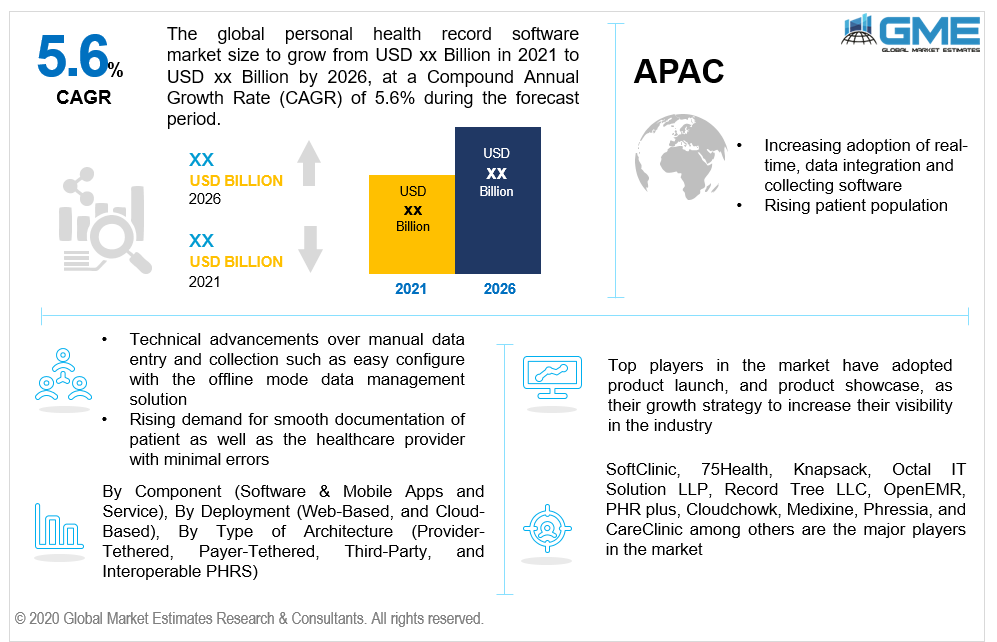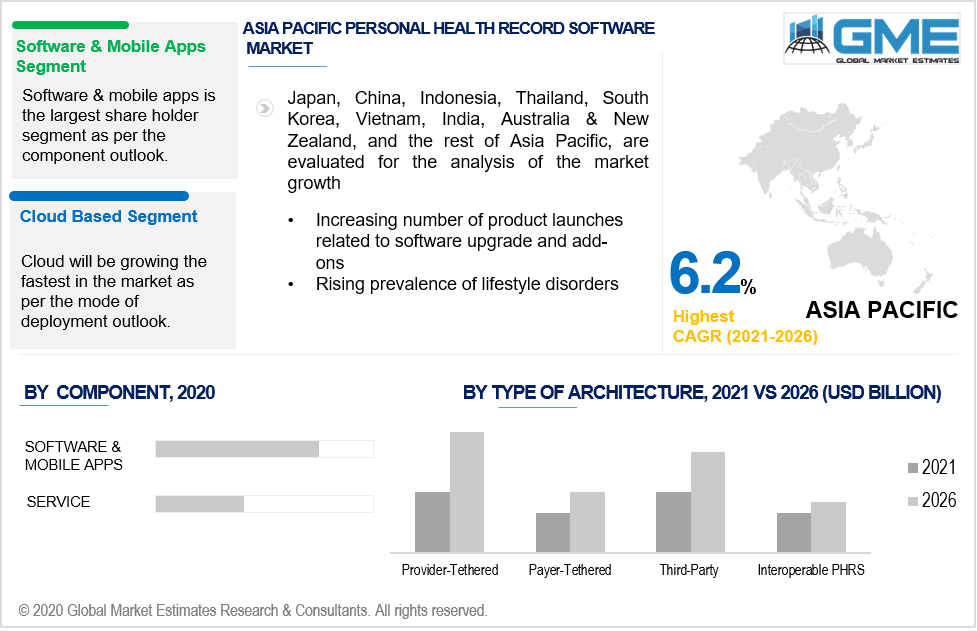
Global Personal Health Record Software Market Size, Trends & Analysis - Forecasts to 2026 By Component (Software & Mobile Apps and Service), By Deployment (Web-Based, and Cloud-Based), By Architecture (Provider-Tethered, Payer-Tethered, Third-Party, and Interoperable PHRS), By Region (North America, Asia Pacific, CSA, Europe, and the Middle East and Africa); End-User Landscape, Company Market Share Analysis, and Competitor Analysis
Also known as the patient portal, PHR software is a solution for patients to maintain their health records and insurance documents. A comprehensive picture of the medical, as well as the current health records, are displayed in the software/ app for the patient and doctors to access during the treatment management process. The basic information feed in the software is a doctor or primary care giver’s name, patient and doctor address details, prescribed medications with dosage details, medical history and important notes on allergies and drug reaction data, detailed information, and analytical presentation of any lifestyle disorder like CVD, diabetes, high blood pressure, etc., past and upcoming surgery details, genetic and hereditary disease information, and detailed history of immunization and ill effects of the same. The end-user for such a product is the patient itself making it one of the most promising products in the healthcare IT industry. Data from other sources such as pharmacy, doctor visit info, drug store, ambulatory care service, hospital and clinics, labs, and caregivers is stored in the most organized format. The ease of ability to create, store, manage and access personal patient information will help the market grow exponentially during 2021-2026.
The market will be positively driven owing to factors such as increasing demand for online and cloud portals to store medical records for the individual patient, rising trend of centralizing and streamlining of healthcare information, high awareness amongst patient for medical data management, and rising government initiatives to promote paperless and errorless data storage in the healthcare industry.

Product and post-sale service are the two major components of this market, in which the product is further segmented into software and apps. Due to rising patient awareness about online healthcare data management, and increasing software launch strategies initiated by top companies in the market, the market for software and apps is definitely on the rise and will continue the trend from 2021 to 2026.
Cloud-based and web-based platforms are the two major segments categorized to explain the mode of deployment for the PHR software market. The cloud segment will be the fastest-growing segment owing to the benefits it offers in terms of real-time data manipulation, data sharing, storage flexibility, reliability, security, and cost-effectiveness.
The four different types of software architectures in the market are, provider-tethered, payer-tethered, third-party, and interoperable PHRS. Provider-tethered PHRs are a part of or have tied up with a particular healthcare organization for their internal record management, whereas payers type have their association with insurance companies or payers systems. The third-party PHR software has unconnected sources and is independent of any association. The market for third-party PHR will be growing the fastest owing to the rising interest of patients to opt for third party services independent of any healthcare organization.

As per the regional analysis, the market for North America is the largest regional market segment. Major reasons being, the increasing awareness of patients to maintain health records regardless of any association with hospitals or clinics, the increasing product launch or software upgrades in countries like the U.S. and Canada, rising government initiatives for funding start-up firms to promote personalized health record software and apps. However, owing to the rising geriatric patient population, rising penetration of computerization in the healthcare industry, increasing access to android or smartphones, the market for the Asia Pacific will be growing faster than Europe, Middle East & Africa, Central and South America, and North America.
SoftClinic, 75Health, Knapsack, Octal IT Solution LLP, Record Tree LLC, OpenEMR, PHR plus, Cloudchowk, Medixine, Phressia, and CareClinic among others are the major players in the market.
Please note: This is not an exhaustive list of companies profiled in the report.
In March 2020, Knapsack launched its free PHR app for senior citizens, youth organizations, addiction treatment centers, and hospitals.
We value your investment and offer free customization with every report to fulfil your exact research needs.
The Global Personal Health Record Software Market has been studied from the year 2019 till 2026. However, the CAGR provided in the report is from the year 2021 to 2026. The research methodology involved three stages: Desk research, Primary research, and Analysis & Output from the entire research process.

The desk research involved a robust background study which meant referring to paid and unpaid databases to understand the market dynamics; mapping contracts from press releases; identifying the key players in the market, studying their product portfolio, competition level, annual reports/SEC filings & investor presentations; and learning the demand and supply side analysis for the Personal Health Record Software Market.

The primary research activity included telephonic conversations with more than 50 tier 1 industry consultants, distributors, and end-use product manufacturers.

Finally, based on the above thorough research process, an in-depth analysis was carried out considering the following aspects: market attractiveness, current & future market trends, market share analysis, SWOT analysis of the companies and customer analytics.

Tailor made solutions just for you
80% of our clients seek made-to-order reports. How do you want us to tailor yours?
OUR CLIENTS